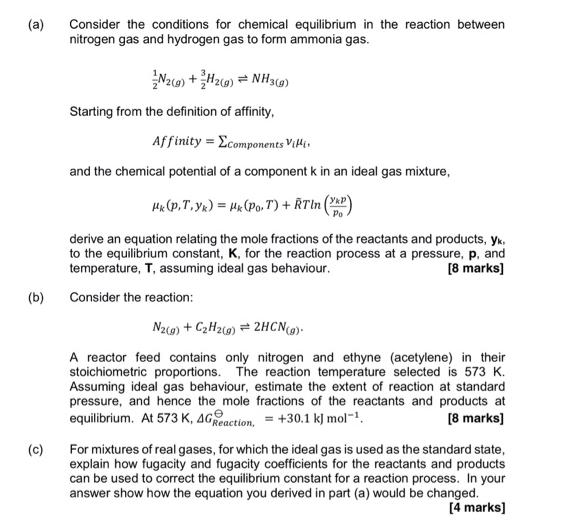Answered step by step
Verified Expert Solution
Question
1 Approved Answer
(a) Consider the conditions for chemical equilibrium in the reaction between nitrogen gas and hydrogen gas to form ammonia gas. Nzco) + Hzc0) =

(a) Consider the conditions for chemical equilibrium in the reaction between nitrogen gas and hydrogen gas to form ammonia gas. Nzco) + Hzc0) = NH3@) Starting from the definition of affinity, Affinity = Ecomponents Vili. and the chemical potential of a component k in an ideal gas mixture, He (p.T.y) = H (Po. T) + RTIn (P) derive an equation relating the mole fractions of the reactants and products, yk, to the equilibrium constant, K, for the reaction process at a pressure, p, and temperature, T, assuming ideal gas behaviour. [8 marks) (b) Consider the reaction: Naca) + C2H2@) = 2HCN@). A reactor feed contains only nitrogen and ethyne (acetylene) in their stoichiometric proportions. The reaction temperature selected is 573 K. Assuming ideal gas behaviour, estimate the extent of reaction at standard pressure, and hence the mole fractions of the reactants and products at equilibrium. At 573 K, AGeaction, = +30.1 kJ mol-1. [8 marks) (c) For mixtures of real gases, for which the ideal gas is used as the standard state, explain how fugacity and fugacity coefficients for the reactants and products can be used to correct the equilibrium constant for a reaction process. In your answer show how the equation you derived in part (a) would be changed. [4 marks]
Step by Step Solution
★★★★★
3.40 Rating (153 Votes )
There are 3 Steps involved in it
Step: 1
Required solution of all the parts are given below ...
Get Instant Access to Expert-Tailored Solutions
See step-by-step solutions with expert insights and AI powered tools for academic success
Step: 2

Step: 3

Ace Your Homework with AI
Get the answers you need in no time with our AI-driven, step-by-step assistance
Get Started


